“Hypoxia” has become a major buzzword in the world of freshwater research as hypoxic conditions have led to varying levels of adverse ecological consequences on ecosystems. In particular, limnologists in North America have focused on studying the hypoxic conditions found throughout the Laurentian Great Lakes. Types of hypoxic conditions observed include:
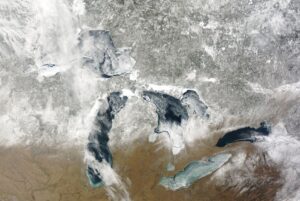
MODIS satellite image of the Great Lakes ice. (Credit: NOAA Great Lakes Environmental Research Laboratory via Flickr CC BY-SA 2.0)
- Hypolimnetic hypoxia
- Over-winter hypoxia
- Diel hypoxia
- Episodic hypoxia
While overall research on hypoxia in the Great Lakes has increased, a disproportionate amount of this research has been conducted in Lake Erie specifically. In a 2021 review published in the Journal of Great Lakes Research, researchers sought to categorize hypoxic conditions and characterize the physical and anthropogenic processes that can lead to the development of hypoxic conditions. Furthermore, the review highlights the oversaturation of research in specific regions and points out the neglect of lesser-studied lakes.
Methods
According to the review’s authors, the surge of research focusing on hypoxia is likely a result of persisting low-oxygen conditions, despite decreases in nutrient loading, and as a means of predicting the impacts and potential worsening of conditions under future climate scenarios.
Though hypoxic zones are typically associated with negative impacts, they can also provide refuge for zooplankton, increase feeding efficiency and consumption from piscivorous fish and may increase commercial fishing catches by concentrating target species in smaller areas.1 Still, the overall impacts of long-lasting and widespread hypoxia can be detrimental to habitats and aquatic flora and fauna as dissolved oxygen (DO) is essential to all forms of aquatic life.
In order to identify knowledge gaps in neglected lakes, researchers searched all databases of the ISI Web of Science using the topic search query for hypoxia and specific Great Lakes. The research reviewed was limited to studies and articles published between 2000 and 2020.
Identifying Types of Hypoxic Conditions
The review defines hypoxia as representing a spectrum of water quality conditions that range from slightly depleted oxygen levels to complete anoxia. Researchers also gathered that hypoxic conditions were likely to form if oxygen consumption exceeded DO generation and if dissolved oxygen concentrations were unable to be replenished from external sources.
The study defines four key types of hypoxia under the following terms:
- Hypolimnetic hypoxia is a gradual, persistent reduction in DO concentrations in the bottom level of the water column following the development of a density gradient that reduces vertical mixing.
- Over-winter hypoxia is the reduction of DO concentration in part or all of the water column following an ice-on event at the air-water interface.
- Diel hypoxia is the daily pattern of oscillating DO concentrations resulting from varying levels of oxygen demand and production in shallow aquatic systems.1
- Episodic hypoxia is the reduction of DO following a “discrete event that results in the sudden intrusion of hypoxic water or allochthonous nutrients into a system.”1
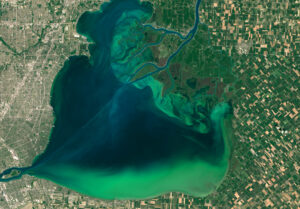
Algae Boom in Lake Erie. (Credit: NASA via Flickr CC BY 2.0)
Results
Generally, these hypoxic conditions are part of the natural hydrological process but have become exacerbated by climate change. For example, over-winter hypoxia can be worsened by longer ice-on events resulting from colder and more severe winters. Likewise, episodic hypoxia can be worsened by increases in high run-off events or recurring pollution.
The ISI Web of Science search found that there was a general increase in Great Lakes hypoxia papers. Unsurprisingly, Lake Erie dominated the research pool, with 78% of articles specific to Lake Erie.1 Having such a concentration of research secluded to one lake makes the job of resource managers more difficult as they must rely on non-local data. The review explains, “Undetected or underestimated hypoxia affecting rocky reefs or other critical spawning habitats may drastically reduce the effectiveness of current and planned improvements to habitat quality.”1 Having a limited understanding of how hypoxic conditions are represented in a target system can mitigate potential benefits that management strategies may have produced. It is therefore recommended that the research surrounding hypoxia in the Great Lakes expand to become more representative of the various lake systems in the region.
Sources
- Joshua M. Tellier, Nicholas I. Kalejs, Benjamin S. Leonhardt, David Cannon, Tomas O. Hӧӧk, Paris D. Collingsworth, Widespread prevalence of hypoxia and the classification of hypoxic conditions in the Laurentian Great Lakes, Journal of Great Lakes Research, Volume 48, Issue 1, 2022, Pages 13-23,




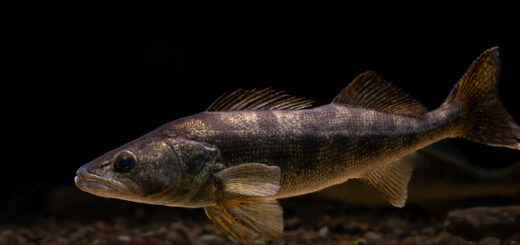
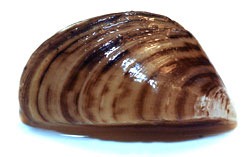

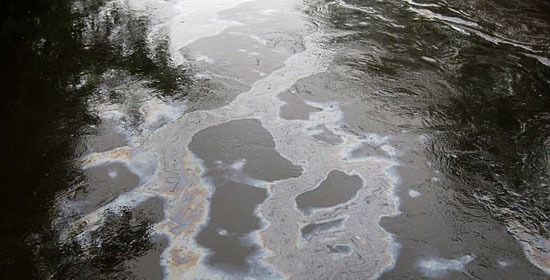
[…] HABs with several human and animal health conditions as well as environmental conditions like hypoxia and light […]
[…] tied to environmental stressors. Nutrient pollution is tied to declines in dissolved oxygen, hypoxia, harmful algal blooms, and other conditions that influence system health. For Lake Erie, the […]
[…] Aquatic vegetation growth is important to the habitat suitability of various ecosystems, and while healthy flora are fundamental to the ecological chain, overgrowth can introduce a host of problems for fish. High-productivity systems, or eutrophic systems, mean a surplus of food available to microorganisms and herbivores, but the overgrowth is also tied to low-light conditions and hypoxia. […]